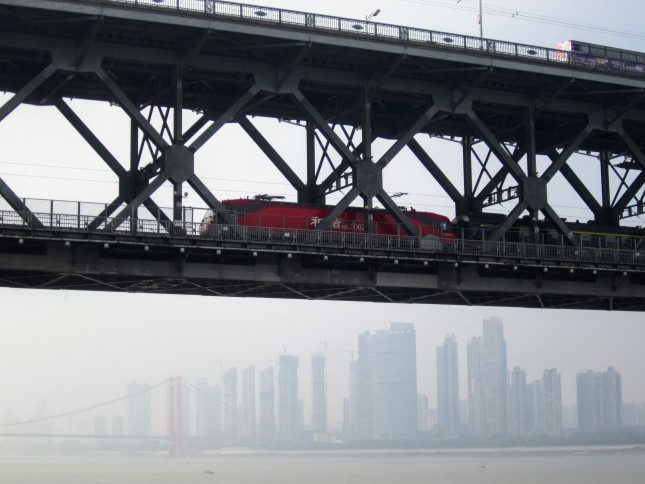-
Decarbonization in the United States and China: Fast and Furious Enough?
October 14, 2021 By Eli Patton
A “code red for humanity”— that is how UN Secretary General António Guterres described the future climate scenarios laid out in the International Panel on Climate Change’s Sixth Assessment Report. According to the report, CO2 in the atmosphere has reached levels unseen in 2 million years, amplifying floods, droughts, and other environmental catastrophes around the world.
There is much anticipation surrounding the upcoming COP26 and expectations are high for China’s climate negotiators’ plans to meet Xi Jinping’s 2060 goals. With China responsible for roughly 25 percent of annual global greenhouse gas emissions and the United States at 15 percent, all eyes will be on these two nations in Glasgow this November. People everywhere are wondering if we will hear more empty promises, or if we will finally see meaningful actions to limit climate change.
Overthrow of China’s dirty king coal?
Starting with China’s economic reforms in the 1980s, the country’s “miracle growth” has been powered by cheap coal. With more than 1,000 existing coal plants, coal accounts for 56.8 percent of China’s energy consumption and half of its CO2 emissions. Air pollution from coal emissions costs China up to 500 billion dollars in lost productivity and 1.7 million early deaths per year.
As a result of that air pollution, China saw a dramatic rise in environmental protests from 10,000 “mass events” in 1994 to 128,000 in 2008, until public security crackdowns swept the country. Then, in 2013, the airpocalypse hit Beijing and other northern cities with small particulate (PM2.5) pollution from coal and car emissions reaching more than 30 times the WHO recommended healthy levels. The government launched a war against pollution in 2014 and thanks to new laws and stringent top-down mandates, air pollution has fallen by 25 to 35 percent in most major cities. Yet 42 of the top 100 polluted cities are still in China.
Xi Jinping has a climate vision
The 13th Five-Year Plan (2016-2020) proclaimed a general goal for China to become an “ecological civilization” living in harmony with nature. Beyond vague slogans, the plan set aggressive targets backed up by considerable investments and policies that improved air quality and helped China become a major developer of clean energy technologies. Today, China leads the world in electric vehicle adoption and emerging energy-efficient building standards, installed wind power capacity, supergrids, and more.
At the 2020 UN General Assembly, Chinese President Xi Jinping promised that China will peak carbon emissions by 2030 and be “carbon neutral” by 2060. This will be accomplished by transitioning to more renewable energy sources and through carbon offsets, such as the Great Green Wall project that aims to plant 88 million acres of forest, stretching 3,000 miles, by 2050. China added 72GW of wind energy and 49GW of solar to its grid in 2020 alone.
China’s grid capacity is currently made up of only 10 percent non-hydro renewables, but Beijing has mandated an increase to 30 percent by 2030. This will be accomplished by installing more than 1.2 billion kilowatts of wind and solar power, and a set maximum coal energy capacity target of 1,100GW nationally.
Despite all of China’s green energy advancements, the war on pollution has been a series of incomplete half steps. For example, in 2015 the central government began a traffic light system for the construction of coal plants with most provinces initially facing red lights. Now after economic slowdown from the pandemic, most have green lights. Provinces are planning to build 200 new coal plants at a time when international energy experts are calling on China to close 600 coal plants in order to meet its Nationally Determined Contributions under the 2015 Paris Agreement. Yet, the 14th Five-Year Plan calls for an increase in the maximum annual coal output of 4.1 billion tons, rather than a decrease from the current 3.9 billion tons.
Race to build a clean energy future at home and abroad
According to Professor Ma Jun from Tsinghua University, all of the cumulative emissions from the existing and planned Belt and Road Initiative (BRI) energy projects will consume the Earth’s entire remaining carbon budget even if all nation’s meet their Paris commitments. Between now and 2040, 60 percent of new energy demand will occur in the Indo-Pacific. This must be green, renewable energy if we are to avoid the worst case climate scenarios. For the United States and China, decarbonization at home must be matched by the decarbonization of investments abroad.
Xi Jinping stunned the world when he announced in September 2021 that China would stop building coal plants abroad. Over the last 20 years, Chinese state-owned banks have invested $200 billion into the energy sector of countries around the world. This investment has dropped off a cliff since 2017, yet it remains to be seen if coal will permanently be dethroned.
On the other side of the Pacific, at the September 2021 Major Economies Forum, President Biden reiterated his plan for a historic investment to “build a clean energy future that creates millions of jobs and ushers in new industries of the future.” The Biden Administration has approved a new offshore wind farm that will drastically increase U.S. installed capacity from 42MW to 800MW. The market for grid battery storage installs in the United States has tripled in the last year alone.
Biden also has pushed to more than triple American investment in energy infrastructure modernization abroad by 2024, up to 100 billion dollars per year. The U.S. Development Finance Corporation, which manages $60 billion to invest in low/mid income countries abroad, announced that its investments will be net zero carbon by 2040. However, with Republicans threatening to filibuster virtually any Democratic climate or other legislation, and moderate Democrats vowing to vote against their own party’s goals, the Biden administration’s climate agenda may ultimately be stunted or blocked entirely.
Getting beyond blah blah blah at Glasgow
Although recent growth in renewable energy installations and other climate action in both the United States and China are significant, they pale in comparison to what is needed. The International Renewable Energy Agency says that global renewable energy investments must drastically increase to 4.4 trillion dollars each year until 2050 if we are to limit climate change impacts. Under the Sixth Assessment Report, the projected 1.5° Celsius scenario is now the least apocalyptic, with the worst predicting a world that is hotter by up to 6° Celsius. As the Wilson Center has recently reported, the implications of climate change to U.S. national security and foreign policy are serious.
Many young people around the world are skeptical that governments will be able or willing to react to the scale and immediacy of the crisis. Speaking recently at the Youth4Climate summit, activist Greta Thunberg implored government action, saying: “There is no planet B. Green economy blah, blah, blah. Net zero by 2050, blah, blah, blah. Climate neutral, blah, blah, blah. They have now had 30 years of blah, blah, blah and where has that led us?” The representatives at Glasgow should listen.
Eli J. Patton is a researcher at Wilson Center’s China Environment Forum. His work is related to the Belt and Road Initiative and the impact that a powerful China has on its neighbors, their societies, governance, and ecosystems. Eli earned an MA in Asian Studies from George Washington University and previously worked as a journalist and translator in Taipei city.
This article is part of a new series of blogs and events focused on China’s decarbonization challenge from the Wilson Center’s China Environment Forum. Upcoming topics will include China’s supergrid development, national carbon trading scheme, the boom in renewables, a Green BRI, and more.
Click here to sign up for our newsletter and be notified of our upcoming events.
Sources: BBC, Bloomberg, Brookings, CECC, CGTN, China Briefing, ClimateWorks, CNBC, CNN, Columbia SIPA, CSIS, Earth.org, The End of An Era by Carl Minzner, GRI-BRI.org, International Affairs Review, IPCC, IQ Air, Nature, OurDailyPlanet, Politico, PV Magazine, NBC News, Reuters, Transition Zero, Union of Concerned Scientists, USCC, U.S. Department of State, U.S. DFC, Whitehouse.gov, Youtube
Lead Photo Credit: A melting glacier in Greenland, used with permission courtesy of Eli Patton/Author.
 A Publication of the Stimson Center.
A Publication of the Stimson Center.









